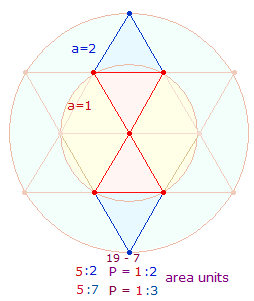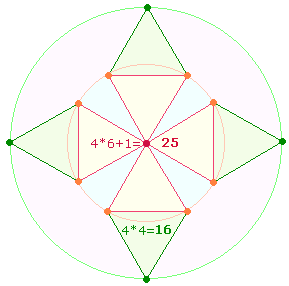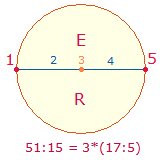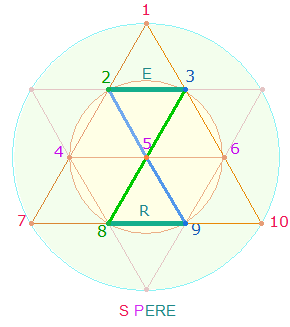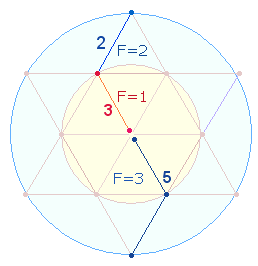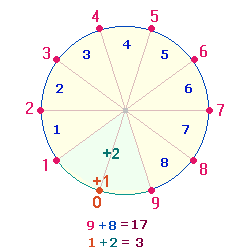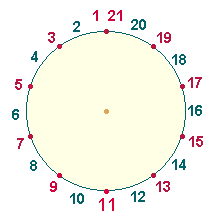gematric calculator (to
be consulted for factoral values)
III. The last sentence (62-63)
d) Structural Elements
This chapter continues the previous one.
QUI NON RISERE PARENTI,
NEC DEUS HUNC MENSA DEA NEC DIGNATA CUBILI
EST.
Those
who have not smiled at their parent,
Neither
a GOD has considered him worthy of his table nor a GODDESS of her bed.
1.
Each verse is a gematric unit. If a sentence
begins before, the whole sentence is constructed as a wider unit. First the
last line has to be examined:
|
|
lett. |
NS |
FS |
sm |
|
lett. |
NS |
FS |
sm |
|
NEC |
3 |
21 |
21 |
42 |
NEC |
3 |
21 |
21 |
42 |
|
DEUS |
4 |
47 |
26 |
73 |
DIGNATA |
7 |
54 |
51 |
105 |
|
HUNC |
4 |
44 |
31 |
75 |
CUBILI |
6 |
54 |
37 |
91 |
|
MENSA |
5 |
49 |
34 |
83 |
(E)ST |
3 |
42 |
32 |
74 |
|
DEA |
3 |
10 |
10 |
20 |
|
|
|
|
|
|
|
19 |
171 |
122 |
293 |
|
19 |
171 |
141 |
312 |
|
312 = 24*13; 293+312 = 605 = 5*11² =
11*55 |
|||||||||
There
are two parallel
word groups, each introduced by NEC. Three
things are most striking: First, the numeral
sums (NS) are equal, second,
the number of letters is equal too, third, 171 is the sum of numbers from 1-18.
2.
There are more gematric parallelisms:
·
Logically, without NEC
each NS is 150.
·
DEUS – MENSA and DEA – CUBILI are content parallelisms. Their NS are 96 and 64,
forming the ratio 32*(3:2). The NS 96 is also obtained
by DIGNATA EST or CUBILI
EST.
·
Twice NEC has the NS 42 like EST. (E is metrically elided.)
·
DIGNATA CUBILI follow each other
with the same NS 54, together 108. The two words form a NS-ratio 18*(6:13) with
the other words. If HUNC is added, another
ratio is 2*19*(4:5).
The 9 words are gematrically interconnected in such a
way that all results are even.
3. In
the previous
chapter it has become evident that Vergil wanted to dedicate
his poem to three persons put in the dative case:
PUERO, MATRI, PARENTI. The 4values are once more presented:
|
|
NS |
FS |
sm |
FV1 |
FV2 |
sm |
GS |
|
PUERO |
71 |
48 |
119 |
71 |
11 |
82 |
201 |
|
MATRI |
58 |
50 |
108 |
31 |
12 |
43 |
151 |
|
sm |
129 |
98 |
227 |
102 |
23 |
125 |
352 |
|
PARENTI |
79 |
69 |
148 |
79 |
26 |
105 |
253 |
|
total |
208 |
167 |
375 |
181 |
49 |
230 |
605 |
|
208 = 16*13 |
|||||||
|
253:352 = 11*(23:32)
= 11*55 = 5*11² |
|||||||
The
coincidence of the 4value result 605
with the NS+FS
of the last line suggests that the three persons are represented in the
gematric construction. This can be shown with the NS of PUERO + PARENTI (150)
and the NS+FS
108 of MATRI. 96
is the NS 57+FS 39 of PUER, 64
the NS of RISU.
312 forms with the NS 208 of the three persons the ratio 8*13*(2:3).
4. It is
also possible to knit together the NS 208 of the three
persons and the inverted sums 352
and 253:
NEC DEUS HUNC 21+47+44 = 112; CUBILI
EST 54+42 = 96;
112:96 = 16*(7:6). 112+96 = 208.
|
|
lett. |
NS |
FS |
sm |
|
lett. |
NS |
FS |
sm |
|
DEUS |
4 |
47 |
26 |
73 |
NEC |
3 |
21 |
21 |
42 |
|
HUNC |
4 |
44 |
31 |
75 |
MENSA |
5 |
49 |
34 |
83 |
|
DIGNATA |
7 |
54 |
51 |
105 |
DEA |
3 |
10 |
10 |
20 |
|
|
|
|
|
|
NEC |
3 |
21 |
21 |
42 |
|
|
|
|
|
|
CUBILI |
6 |
54 |
37 |
91 |
|
|
|
|
|
|
(E)ST |
3 |
42 |
32 |
74 |
|
|
15 |
145 |
108 |
253 |
|
23 |
197 |
155 |
352 |
|
58*(2:3) |
|||||||||
5. The NS+FS of the first
part of the sentence are:
|
|
lett. |
NS |
FS |
sm |
|
QUI |
3 |
45 |
23 |
68 |
|
NON |
3 |
40 |
35 |
75 |
|
RISERE |
6 |
71 |
58 |
129 |
|
PARENTI |
7 |
79 |
69 |
148 |
|
|
19 |
235 |
185 |
420 |
|
l.63 |
38 |
342 |
263 |
605 |
|
|
57 |
577 |
448 |
1025 |
|
185:235 = 5*(37:47) |
||||
|
1025 = 25*41 |
||||
The first part of the sentence consists of 19
letters, half the letters of l. 63. 19 is also the cross sum of 577, a prime number. The three digits refer to the 7 points of the DR which represent 1+2 and 1+3 = 7 area units illustrated by the
following figure:
|
|
25*41 refers to the 41 elements of a cross of double rhombi, whose
hexagonal part consists of 25 elements, so 25:41 elements represent 1:3 area units of the two concentric
tetractys circles:
|
|
Vergil does not always try to model a gematric construction on the
elements of a geometrical figure so as to produce sensible proportions to
by adequate placements. In this case he
chooses the LINEAR option by an alternate
count of the 13 NS+FS:
|
NS+FS1 |
68 |
|
129 |
|
42 |
|
75 |
|
20 |
|
105 |
|
74 |
513 |
|
NS+FS2 |
|
75 |
|
148 |
|
73 |
|
83 |
|
42 |
|
91 |
|
512 |
|
|
|
|
|
|
|
|
|
|
|
|
|
|
|
1025 |
Here the principle of
order consists of two consecutive and
therefore constitutive numbers of their
added sum. Divisibility by 25 is achieved by
3*150 NS, because RISERE PARENTI forms the
third 150-unit. The ratio thus is 25*(18:23). If 23
is composed of 11+12, the FV are 11+7 = 18. 450 can
be increased by the NS+FS
75 of NON so that now the NS+FS ratio is 525:500 =
25*(21:20).
The first 6 FS and 7 last FS enable the ratio 232:216 = 8*(29:27),
and by trial two exact halves can be obtained:
|
NS+FS1 |
23 |
35 |
|
|
|
26 |
31 |
|
|
21 |
51 |
37 |
|
224 |
|
NS+FS2 |
|
|
58 |
69 |
21 |
|
|
34 |
10 |
|
|
|
32 |
224 |
|
|
232 |
216 |
|
|||||||||||
If the NS of the 13 words are subsequently
added up, it is remarkable that the calculation reaches the word DEUS at 303,
which is the NS of the SATOR Square.
|
|
Q |
N |
R |
P |
N |
D |
H |
M |
D |
N |
D |
C |
E |
|
NS |
45 |
40 |
71 |
79 |
21 |
47 |
44 |
49 |
10 |
21 |
54 |
54 |
42 |
|
|
45 |
85 |
156 |
235 |
256 |
303 |
347 |
396 |
406 |
427 |
481 |
535 |
577 |
6. The total FS 448
can be understood as an equation of 4+4=8 that
can be found in a cross of double rhombi with 8+8
frame lines. By the extension of the hexagon to the hexagram the two radial lines
of each diameter are increased by two more radial lines but in such a way that
they look in opposite directions. From the top point of the tetractys the eye follows the zigzag line till the bottom point
(beyond the bottom line of the tetractys), and, recognizing
the form of double rombus, moves on the other zigzag line BACK to the top point.
448 has occurred in
lines 4 to 10
already where the letters RE – BACK, due to the respective content, are
conspicuously more frequent than in the rest of the text. 25 E and 19 R
in these lines equal 125+323 = 448.
The origin of the syllable RE can be seen in the circle axis with its 5 elements:
|
|
RE is here seen from the
second half of the circle. In order to fulflill the condition of a full return
the first half has to be covered for a second time. So RE
in fact is a kind of shortform for ERE.
Vergil seems to
have this circular model in mind as the the processing
of the NS+FS
of the last sentence may prove:
|
|
NS |
FS |
sm |
FW |
|
|
577 |
448 |
1025 |
51 |
|
FW |
577 |
19 |
596 |
153 |
|
sm |
|
|
|
204
|
|
51:153 = 51*(1:3) |
||||
|
596 = 4*149 |
||||
A more developed
form of RE can be derived from a numbered
tetractys:
|
|
The tetractys is
here divided into three parts, and the sums provide the equivalent letters S for the three corner points, P for the central hexagonal axis and ERE for the numbers on the double triangle. Here
again 2 and 3
must be covered a second time to comply with the condition a full return. ERE is the fundamental
model for palindromic numbers:
·
It consists of three halves of a circle, the
third half is identical with the first (51:15).
·
The three palindromic parts coincide with three
hexagonal axes.
·
The returning principle is sanctified and
objectivated by the numbered model of TETRACTYS.
448 can be obtained if
5 subsequent distances leading to the completion
of the return movement are defined by two-digit composite numbers and if their FV are added:
|
|
|
|
|
|
|
sm |
|
|
23 |
38 |
89 |
92 |
23 |
265 |
|
FV |
23 |
21 |
89 |
27 |
23 |
183 |
|
|
|
|
|
|
|
448 |
However, 448 can be the result of a more important concept
which I haven't found so far.
In composite form PERE twice
orbits the inner SATOR Square frame:
|
|
Vergil adopts this
pattern in line 62 in inverted option: QUI NON RISERE PARENTI.
448 can also be
understood as an additive result of two three-digit numbers which themselves
are single digits originally: The NS 235 of the first half of the sentence in line 62 may give a hint. The 10
radial elements on a DR-zigzag line can be
subdivided into 2+3+5:
|
|
The three radial elements represent 2+1+3 area units, so
if the two groups of successive digits are made to two three-digit numbers
their addition equals 448.
7. The 38 letters of the last
line prove to be characterised by palindromic numbers, which convey the idea of
returns to a new start. The first two have already been determined as two equal
NS 171. The next two
palindromic numbers come about by the prime (number) letters:
|
|
|
NEC |
DEUS |
HUNC |
MENSA |
DEA |
NEC |
DIGNATA |
CUBILI |
EST |
|
|
prime lett. |
NS |
21 |
9 |
16 |
19 |
10 |
21 |
45 |
16 |
24 |
181 |
|
letters |
|
3 |
2 |
2 |
3 |
3 |
3 |
6 |
3 |
2 |
27 |
|
compos.lett. |
NS |
– |
38 |
28 |
30 |
– |
– |
9 |
38 |
18 |
161 |
Another
two palindromic numbers are achieved by the
letters that belong to the SATOR-Square:
|
|
|
NEC |
DEUS |
HUNC |
MENSA |
DEA |
NEC |
DIGNATA |
CUBILI |
EST |
|
|
SQ-letters |
NS |
18 |
23 |
13 |
37 |
6 |
18 |
34 |
|
42 |
191 |
|
letters |
|
2 |
2 |
1 |
4 |
2 |
2 |
4 |
– |
3 |
20 |
|
|
FS |
18 |
13 |
13 |
27 |
6 |
18 |
34 |
|
32 |
161
|
|
|
NS+FS |
|
|
|
|
|
|
|
|
|
352 |
|
other lett. |
NS |
3 |
24 |
31 |
12 |
4 |
3 |
20 |
54 |
|
151 |
The NS+FS 352 forms the the ratio of the inverted sums 352:253 = 11*(32:23)
already mentioned.
8. The single digits of the two palindromic sums 181 and 191
represent 1+8+1 units of measure and 1+9+1 delimiting points, according to a circular and a linear
model:
|
|
|
The circular model shows that units of measure have first to be delimited by points and second, only the basic numbers from 1 to 9 are
countable and what is beyond belongs to the DIVINE
sphere outside the categories of space and time. The circular model starts with
point 0 and returns to it whereas the linear
model goes on with a another point so that 21 and the 21 letters
of the Latin alphabet are the perfect manifestation of the decimal system and
especially based on these two palindromic models. The numbers 1-21 can be placed on a circular line for
illustration:
|
|
VERGIL
took the pains to model the last 4 lines on
this described basis of the decimal system. He did so in the following way:
· The
prime letters of line 62 amount to 191 as a parallel to
palindromic 181 of line 63:
|
line 62 |
|
INCIPE |
PARVE |
PUER |
QUI |
NON |
RISERE |
PARENTI |
|
|
SQ-letters |
NS |
21 |
23 |
22 |
|
26 |
44 |
55 |
191 |
|
letters |
|
3 |
3 |
2 |
|
2 |
4 |
5 |
19 |
· The
prime letters of ll. 60 and 61 are:
|
line 60 |
|
INCIPE |
PARVE |
PUER |
RISU |
COGNOSCERE |
MATREM |
|
|
SQ-letters |
NS |
21 |
23 |
22 |
17 |
53 |
42 |
178 |
|
letters |
|
3 |
3 |
2 |
1 |
7 |
4 |
20 |
Vergil chose 178 to match the NS+FS 99+79 of COGNOSCERE.
|
line 61 |
|
MATRI |
LONGA |
DECEM |
TULERUNT |
FASTIDIA |
MENSES |
|
|
SQ-letters |
NS |
37 |
32 |
17 |
84 |
25 |
23 |
218 |
|
letters |
|
3 |
4 |
4 |
6 |
4 |
3 |
24 |
The sum of the first two lines 178+218 is the same as the NS+FS 231+165 = 396 = 36*11 of the numbers 1-21. The prime NS of
ll. 60/61 and ll. 62/63 form the ratio 396:372 =
12*(33:31) = 12*64 = 768 = 3*256 = 3*16².
The number of letters of the 4 lines is 20+24 = 44; 19+27 = 46; 44+46 = 90; 90:54 = 18*(5:3) = 144, which is the total number of
letters of ll. 60-63. 144 is the NS of
the OPERA-grate in the SQ:
|
|
The 54 letters left
correspond to twice the NS of ERE.
9. The SQ-letters of the four lines are:
|
|
A |
E |
N |
R |
T |
|
O |
P |
S |
|
sm |
|
NV |
1 |
5 |
13 |
17 |
19 |
55 |
14 |
15 |
18 |
47 |
102 |
|
frequ. |
12 |
23 |
14 |
12 |
8 |
69 |
4 |
7 |
9 |
20 |
89 |
|
NS |
12 |
115 |
182 |
204 |
152 |
665 |
56 |
105 |
162 |
323 |
988 |
|
FS |
|
|
|
|
|
665 |
36 |
56 |
72 |
164 |
829 |
|
|
|
|
|
|
|
1330 |
|
|
|
487 |
1817 |
|
665:323 = 19*(35:17) = 19*52 = 4*13*19; 323-164 = 159 |
|||||||||||
|
1817 = 79*23 = FW 102 |
|||||||||||
159 is
the difference between the FS 164
and the NS 323 of
the three composite NV,
it coincides with the NS of the 9 letters
of the SQ which occupy the uneven positions between 1
and 5.
52 = 4*13 is the NS of OPERA, 4 double triangles contained in a DR-cross can be used to put together an octahedron. It also sums up the
elements of one double triangle + two rhombi and one fish figure:
|
|
The three figures containing 9
triangles and multiplied with 7 elements equal
63. In this way 52+63
results in 115 = 23*5, which is the sum of 23 E. 2+3+5 has been explained as 10 radial elements further above.
4*13*19 refers to the central
N of the SQ and 4 T. Combined with E
the word NET – He weaves can be read 4 times from the centre. The number of 89 letters can be derived from the 5 central letters: 4*19+13
= 89.
The NS of the 4 lines is 1539
= 81*19. So the ratio of the NS of 89
to 55 letters is 19*(52:29)
= FV 36+48 = 84. 19
may be so important in the last 4 lines because of PUER
with the NS 57 = 3*19.
14 N
have the NS 182 of SATOR OPERA TENET,
which is one half of the SQ.
The total NS+FS 1817 can be understood as 18+17 and the letters SR,
initials of SATOR
ROTAS.
23 is one main factor of
the NS+FS 552 = 24*23 of the SQ. 102 is the NS of PENSATOR, composed of the 8
different letters of the SQ .
Written:
January 2022
